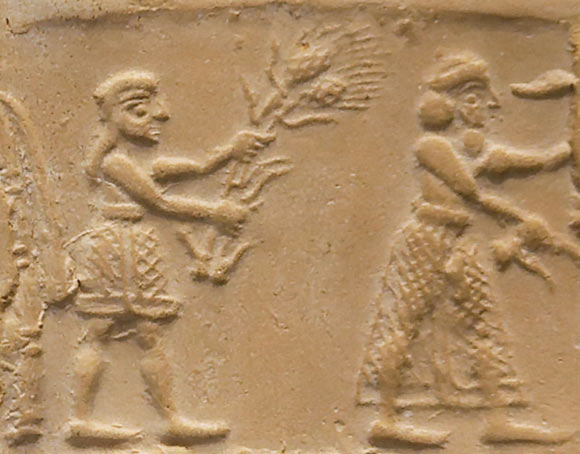New research introduces a paleoenvironmental model in which tidal dynamics influenced the earliest development of agriculture and sociopolitical complexity in Sumer.

The impression of a cylinder seal from the Uruk period, around 3100 BCE. Image credit: Louvre Museum.
The earliest network of city-states, closely knit by shared cultural traditions and economic interests, emerged around 5,000 years ago in southern Mesopotamia.
Collectively referred to as Sumer, this urban florescence was agrarian in nature, sustained by large-scale irrigation systems.
The urbanization of Sumer consolidated a process that started at least a millennium earlier, during the Uruk period (c. 6,000-5,200 years ago), following the long-lasting rural Ubaid culture.
Synergistic increases in population, innovation, and occupational specialization at that time led to the appearance of state structures with complex economies, integrating an urban core with its rural periphery.
This ‘Sumerian takeoff’ could not have happened in the harsh arid tropical zone between the Arabian and Iranian deserts without access to the perennial freshwater sources of the Euphrates and Tigris rivers.
However, it remains uncertain when labor-intensive large-scale irrigation was widely adopted in the region and, prior to that, if and how this water abundance advantage translated into societal affluence.
“Our results show that Sumer was literally and culturally built on the rhythms of water,” said Dr. Liviu Giosan, a researcher at the Woods Hole Oceanographic Institution.
“The cyclical patterns of tides together with delta morphodynamics — how the form or shape of a landscape changes over time due to dynamic processes — were deeply woven into the myths, innovations, and daily lives of the Sumerians.”
The study shows that from about 7,000 to 5,000 years ago, the Persian Gulf extended farther inland, and tides pushed freshwater twice daily far into the lower reaches of the Tigris and Euphrates.
The scholars propose that the early communities must have harnessed this dependable hydrology using short canals to irrigate crops and date groves, enabling high-yield agriculture without the need for large-scale infrastructure.
As rivers built deltas at the head of the Gulf, tidal access to the interior was cut off.
The resulting loss of tides likely triggered an ecological and economic crisis — one that required an ambitious societal response.
The extensive works for irrigation and flood protection that followed ultimately came to define the golden age of Sumer.
“We often picture ancient landscapes as static,” said Dr. Reed Goodman, a researcher at Clemson University.
“But the Mesopotamian delta was anything but. Its restless, shifting land demanded ingenuity and cooperation, sparking some of history’s first intensive farming and pioneering bold social experiments.”
Beyond the environmental drivers, the study also explores the cultural impacts of this watery foundation, connecting the flood myths of Mesopotamia and the water-centered Sumerian pantheon.
“The radical conclusions of this study are clear in what we’re finding at Lagash,” said Dr. Holly Pittman, Director of the Penn Museum’s Lagash Archaeological Project.
“Rapid environmental change fostered inequality, political consolidation, and the ideologies of the world’s first urban society.”
Using ancient environmental and landscape data, new samples from the archaeological site of ancient Lagash, and detailed satellite maps, the authors were able to recreate what the coast of Sumer looked like long ago and imagine how its inhabitants responded to its shape-shifting nature.
“Our work highlights both the opportunities and perils of social reinvention in the face of severe environmental crisis,” Dr. Giosan said.
“Beyond this modern lesson, it is always surprising to find real history hidden in myth — and truly interdisciplinary research like ours can help uncover it.”
The study was published online in the journal PLoS ONE.
_____
L. Giosan & R. Goodman. 2025. Morphodynamic Foundations of Sumer. PLoS One 20 (8): e0329084; doi: 10.1371/journal.pone.0329084







